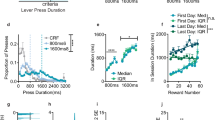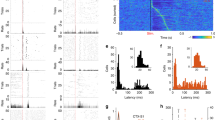Abstract
Human behavior is mostly composed of habitual actions that require little conscious control. Such actions may become invalid if the environment changes, at which point individuals need to switch behavior by overcoming habitual actions that are otherwise triggered automatically. It is unknown how the brain controls this type of behavioral switching. Here we show that the presupplementary motor area (pre-SMA) in the medial frontal cortex has a function in switching from automatic to volitionally controlled action in rhesus macaque monkeys. We found that a group of pre-SMA neurons was selectively activated when subjects successfully switched to a controlled alternative action. Electrical stimulation in the pre-SMA replaced automatic incorrect responses with slower correct responses. A further test suggested that the pre-SMA enabled switching by first suppressing an automatic unwanted action and then boosting a controlled desired action. Our data suggest that the pre-SMA resolves response conflict so that the desired action can be selected.
This is a preview of subscription content, access via your institution
Access options
Subscribe to this journal
Receive 12 print issues and online access
$209.00 per year
only $17.42 per issue
Buy this article
- Purchase on Springer Link
- Instant access to full article PDF
Prices may be subject to local taxes which are calculated during checkout




Similar content being viewed by others
Change history
13 February 2007
replaced
References
Norman, D.A. & Shallice, T. Attention to action: Willed and automatic control of behavior. in Consciousness and Self Regulation: Advances in Research and Theory Vol. 4 (eds. Davidson, R., Schwartz, G. & Shapiro, D.) 1–18 (Plenum, New York, 1986).
Schneider, W. & Chein, J.M. Controlled & automatic processing: behavior, theory, and biological mechanisms. Cogn. Sci. 27, 525–559 (2003).
Monsell, S. Task switching. Trends Cogn. Sci. 7, 134–140 (2003).
Shiffrin, R.M. & Schneider, W. Controlled and automatic human information processing. II. Percepual learning, automatic attending and a general theory. Psychol. Rev. 84, 127–190 (1977).
Logan, G.D. Attention and automaticity in Stroop and priming tasks: theory and data. Cognit. Psychol. 12, 523–553 (1980).
Picard, N. & Strick, P.L. Motor areas of the medial wall: a review of their location and functional activation. Cereb. Cortex 6, 342–353 (1996).
Nakamura, K., Sakai, K. & Hikosaka, O. Neuronal activity in medial frontal cortex during learning of sequential procedures. J. Neurophysiol. 80, 2671–2687 (1998).
Picard, N. & Strick, P.L. Imaging the premotor areas. Curr. Opin. Neurobiol. 11, 663–672 (2001).
Tanji, J. Sequential organization of multiple movements: involvement of cortical motor areas. Annu. Rev. Neurosci. 24, 631–651 (2001).
Schall, J.D., Stuphorn, V. & Brown, J.W. Monitoring and control of action by the frontal lobes. Neuron 36, 309–322 (2002).
Husain, M., Parton, A., Hodgson, T.L., Mort, D. & Rees, G. Self-control during response conflict by human supplementary eye field. Nat. Neurosci. 6, 117–118 (2003).
Botvinick, M.M., Cohen, J.D. & Carter, C.S. Conflict monitoring and anterior cingulate cortex: an update. Trends Cogn. Sci. 8, 539–546 (2004).
Lau, H.C., Rogers, R.D., Haggard, P. & Passingham, R.E. Attention to intention. Science 303, 1208–1210 (2004).
Ridderinkhof, K.R., Ullsperger, M., Crone, E.A. & Nieuwenhuis, S. The role of the medial frontal cortex in cognitive control. Science 306, 443–447 (2004).
Rushworth, M.F., Walton, M.E., Kennerley, S.W. & Bannerman, D.M. Action sets and decisions in the medial frontal cortex. Trends Cogn. Sci. 8, 410–417 (2004).
Luppino, G., Matelli, M., Camarda, R.M., Gallese, V. & Rizzolatti, G. Multiple representations of body movements in mesial area 6 and the adjacent cingulate cortex: an intracortical microstimulation study in the macaque monkey. J. Comp. Neurol. 311, 463–482 (1991).
Matsuzaka, Y., Aizawa, H. & Tanji, J. A motor area rostral to the supplementary motor area (presupplementary motor area) in the monkey: neuronal activity during a learned motor task. J. Neurophysiol. 68, 653–662 (1992).
Matsuzaka, Y. & Tanji, J. Changing directions of forthcoming arm movements: neuronal activity in the presupplementary and supplementary motor area of monkey cerebral cortex. J. Neurophysiol. 76, 2327–2342 (1996).
Shima, K., Mushiake, H., Saito, N. & Tanji, J. Role for cells in the presupplementary motor area in updating motor plans. Proc. Natl. Acad. Sci. USA 93, 8694–8698 (1996).
Dove, A., Pollmann, S., Schubert, T., Wiggins, C.J. & von Cramon, D.Y. Prefrontal cortex activation in task switching: an event-related fMRI study. Brain Res. Cogn. Brain Res. 9, 103–109 (2000).
Rushworth, M.F., Hadland, K.A., Paus, T. & Sipila, P.K. Role of the human medial frontal cortex in task switching: a combined fMRI and TMS study. J. Neurophysiol. 87, 2577–2592 (2002).
Ullsperger, M. & von Cramon, D.Y. Subprocesses of performance monitoring: a dissociation of error processing and response competition revealed by event-related fMRI and ERPs. Neuroimage 14, 1387–1401 (2001).
Garavan, H., Ross, T.J., Kaufman, J. & Stein, E.A. A midline dissociation between error-processing and response-conflict monitoring. Neuroimage 20, 1132–1139 (2003).
Nachev, P., Rees, G., Parton, A., Kennard, C. & Husain, M. Volition and conflict in human medial frontal cortex. Curr. Biol. 15, 122–128 (2005).
Stuphorn, V., Taylor, T.L. & Schall, J.D. Performance monitoring by the supplementary eye field. Nature 408, 857–860 (2000).
Yeung, N., Cohen, J.D. & Botvinick, M.M. The neural basis of error detection: conflict monitoring and the error-related negativity. Psychol. Rev. 111, 931–959 (2004).
Stuphorn, V. & Schall, J.D. Executive control of countermanding saccades by the supplementary eye field. Nat. Neurosci. 9, 925–931 (2006).
Shima, K. & Tanji, J. Role for cingulate motor area cells in voluntary movement selection based on reward. Science 282, 1335–1338 (1998).
Isoda, M. Context-dependent stimulation effects on saccade initiation in the presupplementary motor area of the monkey. J. Neurophysiol. 93, 3016–3022 (2005).
Luppino, G., Matelli, M., Camarda, R. & Rizzolatti, G. Corticocortical connections of area F3 (SMA-proper) and area F6 (pre-SMA) in the macaque monkey. J. Comp. Neurol. 338, 114–140 (1993).
Inase, M., Tokuno, H., Nambu, A., Akazawa, T. & Takada, M. Corticostriatal and corticosubthalamic input zones from the presupplementary motor area in the macaque monkey: comparison with the input zones from the supplementary motor area. Brain Res. 833, 191–201 (1999).
Burman, D.D. & Bruce, C.J. Suppression of task-related saccades by electrical stimulation in the primate's frontal eye field. J. Neurophysiol. 77, 2252–2267 (1997).
Izawa, Y., Suzuki, H. & Shinoda, Y. Suppression of visually and memory-guided saccades induced by electrical stimulation of the monkey frontal eye field. I. Suppression of ipsilateral saccades. J. Neurophysiol. 92, 2248–2260 (2004).
Izawa, Y., Suzuki, H. & Shinoda, Y. Suppression of visually and memory-guided saccades induced by electrical stimulation of the monkey frontal eye field. II. Suppression of bilateral saccades. J. Neurophysiol. 92, 2261–2273 (2004).
Huerta, M.F., Krubitzer, L.A. & Kaas, J.H. Frontal eye field as defined by intracortical microstimulation in squirrel monkeys, owl monkeys, and macaque monkeys. II. Cortical connections. J. Comp. Neurol. 265, 332–361 (1987).
Parthasarathy, H.B., Schall, J.D. & Graybiel, A.M. Distributed but convergent ordering of corticostriatal projections: analysis of the frontal eye field and the supplementary eye field in the macaque monkey. J. Neurosci. 12, 4468–4488 (1992).
Bates, J.F. & Goldman-Rakic, P.S. Prefrontal connections of medial motor areas in the rhesus monkey. J. Comp. Neurol. 336, 211–228 (1993).
Wang, Y., Isoda, M., Matsuzaka, Y., Shima, K. & Tanji, J. Prefrontal cortical cells projecting to the supplementary eye field and presupplementary motor area in the monkey. Neurosci. Res. 53, 1–7 (2005).
Mink, J.W. The basal ganglia: focused selection and inhibition of competing motor programs. Prog. Neurobiol. 50, 381–425 (1996).
Hikosaka, O., Takikawa, Y. & Kawagoe, R. Role of the basal ganglia in the control of purposive saccadic eye movements. Physiol. Rev. 80, 953–978 (2000).
Nambu, A., Tokuno, H. & Takada, M. Functional significance of the cortico-subthalamo-pallidal 'hyperdirect' pathway. Neurosci. Res. 43, 111–117 (2002).
Parent, A., Bouchard, C. & Smith, Y. The striatopallidal and striatonigral projections: two distinct fiber systems in primate. Brain Res. 303, 385–390 (1984).
Hikosaka, O., Sakamoto, M. & Miyashita, N. Effects of caudate nucleus stimulation on substantia nigra cell activity in monkey. Exp. Brain Res. 95, 457–472 (1993).
Nambu, A. et al. Excitatory cortical inputs to pallidal neurons via the subthalamic nucleus in the monkey. J. Neurophysiol. 84, 289–300 (2000).
Aron, A.R. & Poldrack, R.A. Cortical and subcortical contributions to Stop signal response inhibition: role of the subthalamic nucleus. J. Neurosci. 26, 2424–2433 (2006).
Ding, L. & Hikosaka, O. Comparison of reward modulation in the frontal eye field and caudate of the macaque. J. Neurosci. 26, 6695–6703 (2006).
Fujii, N., Mushiake, H. & Tanji, J. Distribution of eye- and arm-movement-related neuronal activity in the SEF and in the SMA and Pre-SMA of monkeys. J. Neurophysiol. 87, 2158–2166 (2002).
Yamamoto, J. et al. Human eye fields in the frontal lobe as studied by epicortical recording of movement-related cortical potentials. Brain 127, 873–887 (2004).
Efron, B. & Tibshirani, R.J. An Introduction to the Bootstrap (Chapman & Hall/CRC, Boca Raton, Florida, USA, 1993).
Thompson, K.G., Hanes, D.P., Bichot, N.P. & Schall, J.D. Perceptual and motor processing stages identified in the activity of macaque frontal eye field neurons during visual search. J. Neurophysiol. 76, 4040–4055 (1996).
Acknowledgements
We are grateful to B.G. Cumming for help in statistical analysis, R.H. Wurtz, R.J. Leigh, K. Nakamura, L. Ding and M. Matsumoto for comments and discussions and M.K. Smith, J.W. McClurkin, T.W. Ruffner, A.M. Nichols, A.V. Hays and L.P. Jensen for technical assistance. This work was supported by the intramural research program of the National Eye Institute.
Author information
Authors and Affiliations
Contributions
M.I. and O.H. jointly designed the study, performed the experiments, conducted the data analyses and wrote the manuscript.
Corresponding author
Ethics declarations
Competing interests
The authors declare no competing financial interests.
Supplementary information
Supplementary Fig. 1
Estimation of the pre-SMA efferent conduction delay. (PDF 25 kb)
Supplementary Figure 2
Schematic illustration of the locations of neuronal recording and electrical stimulation. (PDF 178 kb)
Rights and permissions
About this article
Cite this article
Isoda, M., Hikosaka, O. Switching from automatic to controlled action by monkey medial frontal cortex. Nat Neurosci 10, 240–248 (2007). https://doi.org/10.1038/nn1830
Received:
Accepted:
Published:
Issue Date:
DOI: https://doi.org/10.1038/nn1830
This article is cited by
-
Architecture of the subthalamic nucleus
Communications Biology (2024)
-
Neurophysiological mechanisms of error monitoring in human and non-human primates
Nature Reviews Neuroscience (2023)
-
A macroscopic link between interhemispheric tract myelination and cortico-cortical interactions during action reprogramming
Nature Communications (2022)
-
Dynamic causal brain circuits during working memory and their functional controllability
Nature Communications (2021)
-
Towards real-world generalizability of a circuit for action-stopping
Nature Reviews Neuroscience (2021)



